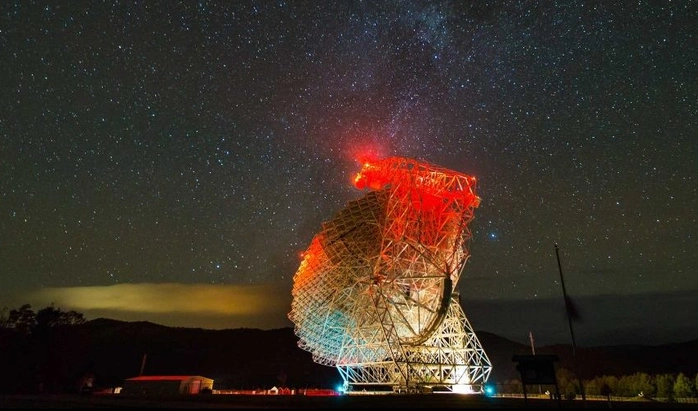WE’VE BEEN UNMASKED: Scientists Warn Radar Technology Could Be Our Downfall Against Alien Detection! H
7-9 minutes 7/11/2025
Imagine a scenario where humanity’s own technology betrays our presence to curious extraterrestrial civilizations light-years away. A groundbreaking study from the University of Manchester suggests that electromagnetic leakage from our radar systems—used in airports and military bases—could be shouting our existence to the stars. Published in Sci-News, the research highlights how these unintentional signals might be detectable by advanced alien observers, potentially turning our radar networks into cosmic beacons. This discovery raises profound questions about our place in the universe and the possibility of contact with extraterrestrial life. Let’s explore how our radar systems could be exposing us, the star systems that might be listening, and what this means for humanity’s search for cosmic neighbors.

Radar Leakage: An Unintentional Cosmic Signal
Radar systems, critical for aviation, navigation, and defense, emit powerful radio waves that guide planes, track weather, and monitor threats. According to the University of Manchester’s research, these systems also produce significant electromagnetic leakage—unintended radio emissions that escape into space. Unlike deliberate signals sent by projects like SETI (Search for Extraterrestrial Intelligence), these radar emissions are passive, yet potent enough to travel vast interstellar distances. The study, led by Dr. Ramiro Caisse Saide, used comprehensive simulations to model how these signals could be detected by alien civilizations with technology comparable to Earth’s Green Bank Telescope in West Virginia, a 100-meter dish capable of capturing faint radio waves.
Dr. Saide explains, “We found that airport radar systems emit radio signals strong enough to be detected up to 200 light-years away by telescopes equivalent to the Green Bank Telescope.” This range encompasses thousands of star systems, significantly increasing the odds that an advanced civilization could notice us. For context, the Green Bank Telescope can detect signals as weak as 10^-26 watts per square meter, making it a benchmark for what alien technology might achieve. The study highlights that both civilian airport radars, like those used for air traffic control, and military radar systems, such as those for missile defense, contribute to this leakage. These emissions, typically in the 1–10 GHz frequency range, are distinct from natural cosmic noise, making them recognizable as “technosignatures”—indicators of technological activity.
The implications are staggering. Radar systems have been operational since the mid-20th century, meaning humanity has been broadcasting these signals for over 80 years. If an alien civilization within 80 light-years has the capability to detect these emissions, they may already know we’re here. This passive leakage, unlike targeted SETI messages, requires no intent, making it a universal byproduct of any technological civilization. The discovery underscores the dual nature of our technology: essential for our infrastructure, yet potentially exposing us to the cosmos.
Potential Alien Observers: Six Star Systems in Focus
The Manchester team identified six nearby star systems where advanced civilizations, if present, could detect our radar leakage. These include Barnard’s Star (5.96 light-years away), HD 48948 (19.3 light-years), HD 40307 (42 light-years), AU Microscopii (32 light-years), HD 216520 (66 light-years), and LHS 475 (40.7 light-years). Each system hosts planets, some of which are in the habitable zone—where liquid water could exist, a key ingredient for life as we know it. For example, HD 40307 has six known planets, including three super-Earths in its habitable zone, while LHS 475 hosts a confirmed Earth-sized exoplanet, discovered by NASA’s TESS mission in 2022.

These systems are prime candidates for alien observation because of their proximity and potential for life. Barnard’s Star, the closest on the list, is a red dwarf with a known planet, Barnard’s Star b, though it’s likely too cold for life. AU Microscopii, a young star with a debris disk, could harbor developing planets, while HD 216520’s massive planets suggest a dynamic system. If intelligent life exists in these systems with radio telescopes as advanced as ours, our radar signals—traveling at the speed of light—could already be under scrutiny. The study estimates that a telescope with Green Bank’s sensitivity could detect Earth’s radar emissions from these distances, especially from high-power systems like the Eglin Air Force Base radar in Florida, which emits pulses up to 2.8 MW.
This raises a tantalizing possibility: what if these civilizations are not only detecting us but also responding? The Manchester team notes that our own SETI efforts, using telescopes like Green Bank and Australia’s Parkes Observatory, are actively scanning these systems for similar technosignatures. The symmetry is striking—if we’re leaking signals, alien civilizations might be doing the same, offering a mutual opportunity for detection.
The Bigger Picture: Opportunity and Risk
The discovery of radar leakage as a potential beacon for extraterrestrial life is both thrilling and sobering. On one hand, it represents an opportunity for contact. If advanced civilizations are scanning the skies, our radar emissions could serve as an unintentional invitation, sparking first contact without the need for deliberate messaging. This aligns with the goals of SETI, which has long sought to detect alien signals while debating whether to broadcast our own. The Manchester study suggests we’ve been broadcasting all along, albeit accidentally, broadening the scope of the search for intelligent life.
On the other hand, the leakage poses risks. Not all extraterrestrial civilizations, if they exist, may be benevolent. Scientists like Stephen Hawking have warned that announcing our presence could attract unwanted attention, drawing parallels to historical encounters between civilizations of unequal technological advancement. The study doesn’t speculate on alien intentions but emphasizes the need to understand our electromagnetic footprint. As humanity develops more powerful radar systems—such as those planned for next-generation air traffic control or space defense—the strength and reach of these signals will only increase, amplifying our visibility.
On social media platforms like Facebook, this story is a perfect blend of science and speculation, capturing the imagination of users who love pondering life beyond Earth. Posts on X already show excitement, with comments like “Are we shouting to aliens without knowing?” and “Webb and now radar—space is getting wild!” The idea that our everyday technology could be a cosmic signal resonates with both science enthusiasts and casual readers, sparking discussions about humanity’s role in the universe. As we continue to explore, the Cat’s Paw Nebula (recently imaged by Webb) and now radar leakage remind us that the cosmos is full of surprises waiting to be uncovered.
The University of Manchester’s study on radar leakage reveals a fascinating truth: our technology may already be announcing humanity’s presence to alien civilizations. From airport radars to military systems, these unintentional signals could be detected by advanced observers in star systems like Barnard’s Star or HD 40307, up to 200 light-years away. This discovery is a double-edged sword, offering the thrilling possibility of contact while raising questions about our cosmic visibility. As we celebrate breakthroughs like the James Webb Space Telescope’s cosmic imagery, the radar study reminds us that we’re not just observers but participants in the universe’s grand narrative.



